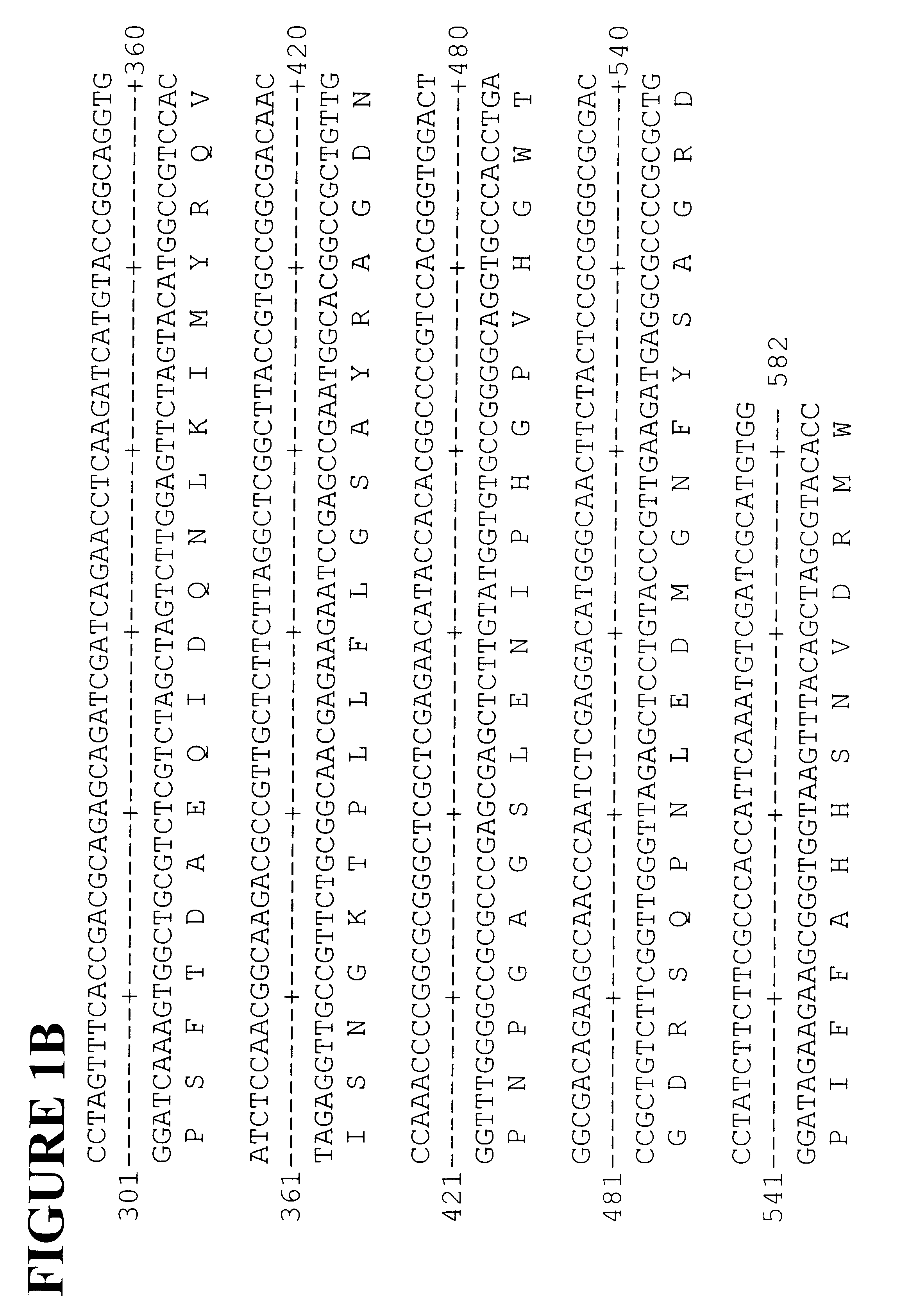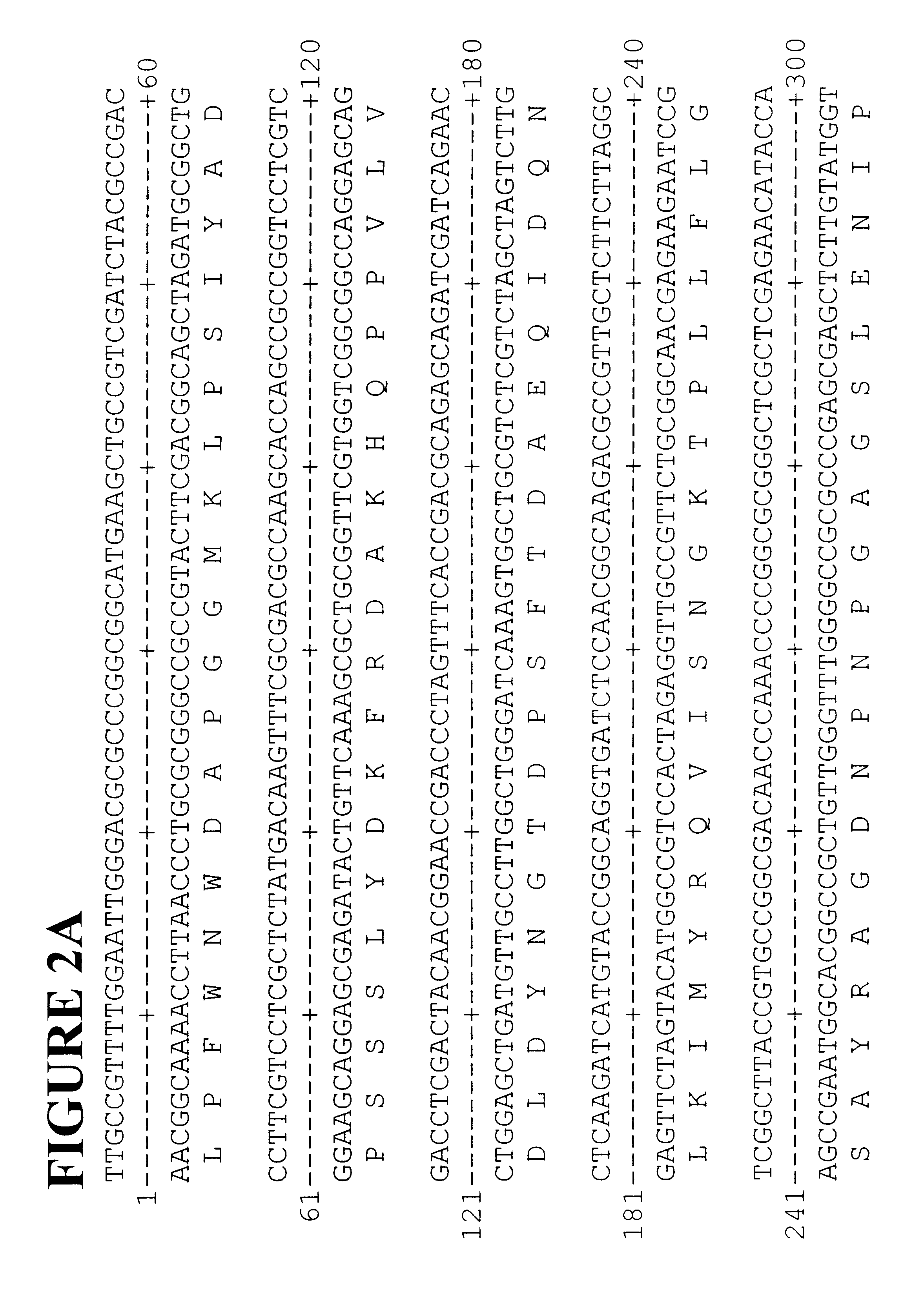Polyphenyl oxidase genes from banana
a polyphenyl oxidase and banana technology, applied in the field of polyphenyl oxidase genes from bananas, can solve problems such as difficult to resolve ppo fragments
- Summary
- Abstract
- Description
- Claims
- Application Information
AI Technical Summary
Benefits of technology
Problems solved by technology
Method used
Image
Examples
example 2
Cloning Banana PPO Genes
Total RNA was isolated from young banana fruit. Fruit tissue (3 g) was frozen and ground to a fine powder in liquid nitrogen with a coffee grinder then added to 20 ml of extraction buffer (2% hexadecyltrimethylammonium bromide (CTAB), 2% polyvinyl pyrolidone, 100 mM Tris-HCl, pH 8.0, 25 mM EDTA, 2 M NaCl, 0.05% spermidine, 2% .beta.-mercaptoethanol) at 65.degree. C. The extract was mixed with 20 ml of chloroform / IAA then centrifuged for 20 minutes at 5,000 RPM and the aqueous phase was re-extracted with chloroform / IAA. The aqueous phase was filtered through Miracloth and 0.25 volumes of 10 M LiCl were added then the sample was incubated overnight at 4.degree. C. before centrifuging for 20 minutes at 8,000 RPM. The supernatant was removed and the pellet was resuspended in 0.5 ml of 1 M NaCl, 0.5% SDS, 10 mM Tris, pH 8.0, 1 mM EDTA. The RNA was extracted once with an equal volume of chloroform / IAA and 2 volumes of ethanol was added. After incubation for 40 mins...
example 3
Cloning Banana Peel PPO Genes
Total RNA was isolated from the peel of young banana fruit. Fruit tissue (3 g) was frozen and ground to a fine powder in liquid nitrogen with a coffee grinder then added to 20 ml of extraction buffer (2% hexadecyltrimethylammonium bromide (CTAB), 2% polyvinyl pyrrolidone, 100 mM Tris-CHl, pH 8.0, 25 mM EDTA, 2 M NaCl, 0.05% spermidine, 2% .beta.-mercaptoethanol) at 65.degree. C. The extract was mixed with 20 ml of chloroform / IAA then centrifuged for 20 minutes at 5,000 RPM and the aqueous phase was re-extracted with chloroform / IAA. The aqueous phase was filtered through Miracloth and 0.25 volumes of 10 M LiCl were added then the sample was incubated overnight at 4.degree. C. before centrifuging for 20 minutes at 8,000 RPM. The supernatant was removed and the pellet was resuspended in 0.5 ml of 1 M NaCl, 0.5% SDS, 10 mM Tris, pH 8.0, 1 mM EDTA. The RNA was extracted once with an equal volume of chloroform / IAA and 2 volumes of ethanol was added. After incu...
example 4
Cloning Tobacco Leaf PPO Genes
Total RNA was isolated from young leaves (1-3 cm long) of glasshouse grown plants. Approximately 2 g of frozen leaf material was ground to a fine powder in liquid nitrogen then extracted in 15 ml of extraction buffer (50 mM Tris-HCl, pH 9.0, 150 mM LiCl, 5 mM EDTA, 5% SDS and 0.6% .beta.-mercaptoethanol) by shaking vigorously in a 50 ml screw cap tube for 1-2 minutes. Approximately 15 ml of phenol / chloroform / IAA (25:24:1) was added and the homogenate mixed then centrifuged for 15 minutes at 5,000 RPM, 4.degree. C. The upper aqueous phase was removed and re-extracted twice with phenol / chloroform / IAA and then once with chloroform / IAA and then centrifuged for 10 minutes at 5,000 RPM, 4.degree. C. The supernatant was removed, LiCl was added to a final concentration of 2 M and the mixture was incubated overnight at 4.degree. C. After centrifuging for 10 minutes at 8,000 RPM, 4.degree. C. The supernatant was removed and the pellet was resuspended in 6 ml of 0...
PUM
| Property | Measurement | Unit |
|---|---|---|
| volume | aaaaa | aaaaa |
| pH | aaaaa | aaaaa |
| pH | aaaaa | aaaaa |
Abstract
Description
Claims
Application Information
 Login to View More
Login to View More - R&D
- Intellectual Property
- Life Sciences
- Materials
- Tech Scout
- Unparalleled Data Quality
- Higher Quality Content
- 60% Fewer Hallucinations
Browse by: Latest US Patents, China's latest patents, Technical Efficacy Thesaurus, Application Domain, Technology Topic, Popular Technical Reports.
© 2025 PatSnap. All rights reserved.Legal|Privacy policy|Modern Slavery Act Transparency Statement|Sitemap|About US| Contact US: help@patsnap.com



